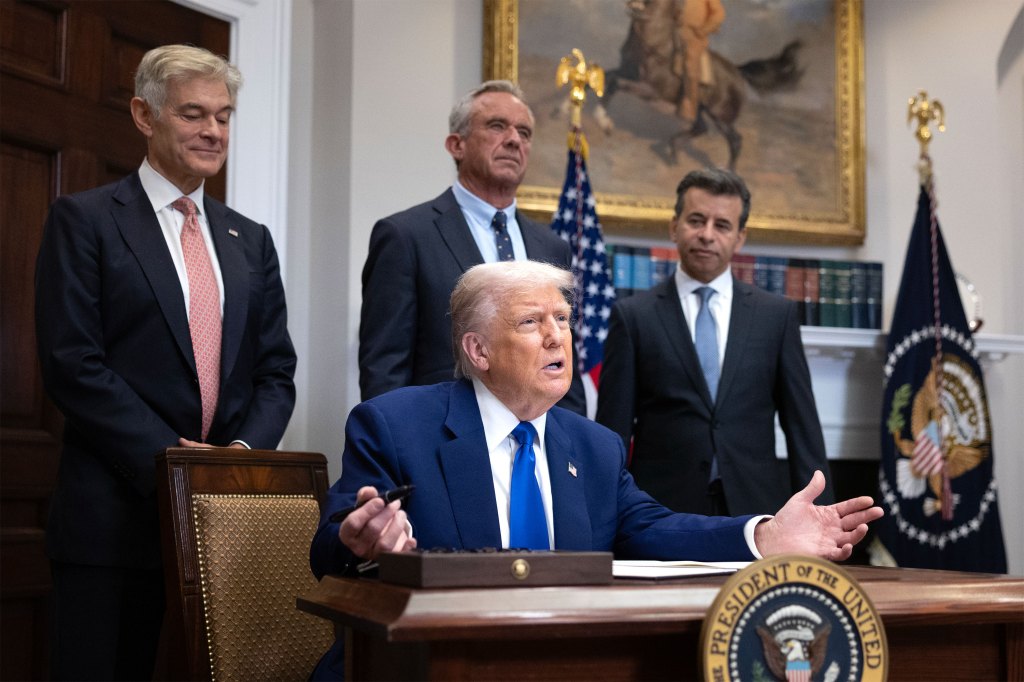Health care has proved a vulnerable target for the firehose of cuts and policy changes President Donald Trump ordered in the name of reducing waste and improving efficiency. But most of the impact isn’t as tangible as, say, higher egg prices at the grocery store.
One thing experts from a wide range of fields, from basic science to public health, agree on: The damage will be varied and immense. “It’s exceedingly foolish to cut funding in this way,” said Harold Varmus, a Nobel Prize-winning scientist and former director of both the National Institutes of Health and the National Cancer Institute.
The blaze of cuts have yielded nonsensical and perhaps unintended consequences. Consider instances in which grant funding gets canceled after two years of a three-year project. That means, for example, that $2 million has already been spent but there will be no return on that investment.
Some of the targeted areas are not administration priorities. That includes the abrupt termination of studies on long covid, which afflicts more than 100,000 Americans, and the interruption of work on mRNA vaccines, which hold promise not just in infectious disease but also in treating cancer.
While charitable dollars have flowed in to plug some gaps, “philanthropy cannot replace federal funding,” said Dustin Sposato, communications manager for the Science Philanthropy Alliance, a group that works to boost support from charities for basic science research.
Here are critical ways in which Trump administration cuts — proposed and actual — could affect American health care and, more important, the health of American patients.
Cuts to the National Institutes of Health: The Trump administration has cut $2.3 billion in new grant funding since its term began, as well as terminated existing grants on a wide range of topics — vaccine hesitancy, HIV/AIDS, and covid-19 — that do not align with its priorities. National Institutes of Health grants do have yearly renewal clauses, but it is rare for them to be terminated, experts say. The administration has also cut “training grants” for young scientists to join the NIH.
Why It Matters: The NIH has long been a crucible of basic science research — the kind of work that industry generally does not do. Most pharmaceutical patents have their roots in work done or supported by the NIH, and many scientists at pharmaceutical manufacturers learned their craft at institutions supported by the NIH or at the NIH itself. The termination of some grants will directly affect patients since they involved ongoing clinical studies on a range of conditions, including pediatric cancer, diabetes, and long covid. And, more broadly, cuts in public funding for research could be costly in the longer term as a paucity of new discoveries will mean fewer new products: A 25% cut to public research and development spending would reduce the nation’s economic output by an amount comparable to the decline in gross domestic product during the Great Recession, a new study found.
Cuts to Universities: The Trump administration also tried to deal a harrowing blow — currently blocked by the courts — to scientific research at universities by slashing extra money that accompanies research grants for “indirect costs,” like libraries, lab animal care, support staff, and computer systems.
Why It Matters: Wealthier universities may find the funds to make up for draconian indirect cost cuts. But poorer ones — and many state schools, many of them in red states — will simply stop doing research. A good number of crucial discoveries emerge from these labs. “Medical research is a money-losing proposition,” said one state school dean with former ties to the Ivies. (The dean requested anonymity because his current employer told him he could not speak on the record.) “If you want to shut down research, this will do it, and it will go first at places like the University of Tennessee and the University of Arkansas.” That also means fewer opportunities for students at state universities to become scientists.
Cuts to Public Health: These hits came in many forms. The administration has cut or threatened to cut long-standing block grants from the Centers for Disease Control and Prevention; covid-related grants; and grants related to diversity, equity, and inclusion activities — which often translated into grants to improve health care for the underserved. Though the covid pandemic has faded, those grants were being used by states to enhance lab capacity to improve detection and surveillance. And they were used to formally train the nation’s public health workforce, many of whom learn on the job.
Why It Matters: Public health officials and researchers were working hard to facilitate a quicker, more thoughtful response to future pandemics, of particular concern as bird flu looms and measles is having a resurgence. Mati Hlatshwayo Davis, the St. Louis health director, had four grants canceled, three in one day. One grant that fell under the covid rubric included programs to help community members make lifestyle changes to reduce the risk of hypertension and diabetes — the kind of chronic diseases that Health and Human Services Secretary Robert F. Kennedy Jr. has said he will focus on fighting. Others paid the salaries of support staff for a wide variety of public health initiatives. “What has been disappointing is that decisions have been made without due diligence,” she said.
Health-Related Impact of Tariffs: Though Trump has exempted prescription drugs from his sweeping tariffs on most imports thus far, he has not ruled out the possibility of imposing such tariffs. “It’s a moving target,” said Michael Strain, an economist at the American Enterprise Institute, noting that since high drug prices are already a burden, adding any tax to them is problematic.
Why It Matters: That supposed exemption doesn’t fully insulate American patients from higher costs. About two-thirds of prescription drugs are already manufactured in the U.S. But their raw materials are often imported from China — and those enjoy no tariff exemption. Many basic supplies used in hospitals and doctors’ offices — syringes, surgical drapes, and personal protective equipment — are imported, too. Finally, even if the tariffs somehow don’t themselves magnify the price to purchase ingredients and medical supplies, Americans may suffer: Across-the-board tariffs on such a wide range of products, from steel to clothing, means fewer ships will be crossing the Pacific to make deliveries — and that means delays. “I think there’s an uncomfortably high probability that something breaks in the supply chain and we end up with shortages,” Strain said.
Changes to Medicaid: Trump has vowed to protect Medicaid, the state-federal health insurance program for Americans with low incomes and disabilities. But House Republicans have eyed the program as a possible source of offsets to help pay for what Trump calls “the big, beautiful bill” — a sweeping piece of budget legislation to extend his 2017 tax cuts. The amount of money GOP leaders have indicated they could squeeze from Medicaid, which now covers about 20% of Americans, has been in the hundreds of billions of dollars. But deep cuts are politically fraught.
To generate some savings, administration officials have at times indicated they are open to at least some tweaks to Medicaid. One idea on the table — work requirements — would require adults on Medicaid to be working or in some kind of job training. (Nearly two-thirds of Medicaid recipients ages 19-64 already work.)
Why It Matters: In 2024 the uninsured rate was 8.2%, near the all-time low, in large part because of the Medicaid expansion under the 2010 Affordable Care Act. Critics say work requirements are a backhanded way to slim down the Medicaid rolls, since the paperwork requirements of such programs have proved so onerous that eligible people drop out, causing the uninsured rate to rise. A Congressional Budget Office report estimates that the proposed change would reduce coverage by at least 7.7 million in a decade. This leads to higher rates of uncompensated care, putting vulnerable health care facilities — think rural hospitals — at risk.
KFF Health News is a national newsroom that produces in-depth journalism about health issues and is one of the core operating programs at KFF—an independent source of health policy research, polling, and journalism. Learn more about KFF.
USE OUR CONTENT
This story can be republished for free (details).






